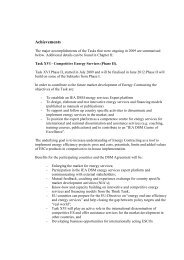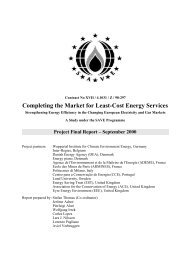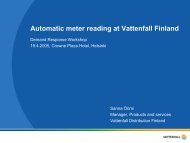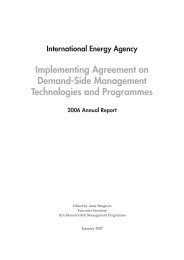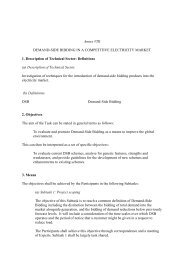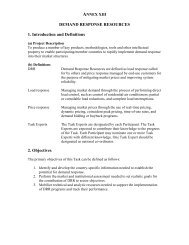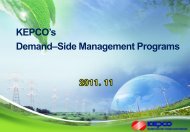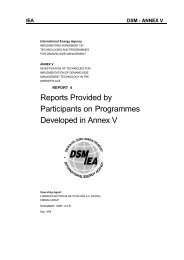Summary and conclusions - IEA Demand Side Management ...
Summary and conclusions - IEA Demand Side Management ...
Summary and conclusions - IEA Demand Side Management ...
Create successful ePaper yourself
Turn your PDF publications into a flip-book with our unique Google optimized e-Paper software.
Appendix 2 Overview of the <strong>IEA</strong> Dem<strong>and</strong>-<strong>Side</strong><strong>Management</strong> Programme<strong>IEA</strong> Dem<strong>and</strong> <strong>Side</strong> <strong>Management</strong> ProgrammeThe Dem<strong>and</strong>-<strong>Side</strong> <strong>Management</strong> (DSM) Programme is one of more than 40 co-operative energytechnology programmes within the framework of the International Energy Agency (<strong>IEA</strong>).The Dem<strong>and</strong>-<strong>Side</strong><strong>Management</strong> (DSM) Programme, which was initiated in 1993, deals with a variety of strategies to reduceenergy dem<strong>and</strong>. The following 16 member countries <strong>and</strong> the European Commission have been working toidentify <strong>and</strong> promote opportunities for DSM:AustriaBelgiumCanadaFinl<strong>and</strong>FranceIndiaItalyRepublic of KoreaNetherl<strong>and</strong>sNorwayNew Zeal<strong>and</strong>SpainSwedenSwitzerl<strong>and</strong>United KingdomUnited StatesSponsors: RAPProgramme Vision during the period 2008 - 2012: Dem<strong>and</strong> side activities should be active elements<strong>and</strong> the first choice in all energy policy decisions designed to create more reliable <strong>and</strong> more sustainableenergy systemsProgramme Mission: Deliver to its stakeholders, materials that are readily applicable for them in crafting<strong>and</strong> implementing policies <strong>and</strong> measures. The Programme should also deliver technology <strong>and</strong>applications that either facilitate operations of energy systems or facilitate necessary markettransformationsThe Programme’s work is organized into two clusters: The load shape cluster, <strong>and</strong> The load level cluster.The ‘load shape” cluster will include Tasks that seek to impact the shape of the load curve over very short(minutes-hours-day) to longer (days-week-season) time periods. Work within this cluster primarilyincreases the reliability of systems. The “load level” will include Tasks that seek to shift the load curve tolower dem<strong>and</strong> levels or shift between loads from one energy system to another. Work within this clusterprimarily targets the reduction of emissions.A total of 24 projects or “Tasks” have been initiated since the beginning of the DSM Programme. Theoverall program is monitored by an Executive Committee consisting of representatives from eachcontracting party to the Implementing Agreement. The leadership <strong>and</strong> management of the individual Tasksare the responsibility of Operating Agents. These Tasks <strong>and</strong> their respective Operating Agents are:Task 1 International Database on Dem<strong>and</strong>-<strong>Side</strong> <strong>Management</strong> & Evaluation Guidebook on the Impact ofDSM <strong>and</strong> EE for Kyoto’s GHG Targets - CompletedHarry Vreuls, NOVEM, the Netherl<strong>and</strong>sTask 2 Communications Technologies for Dem<strong>and</strong>-<strong>Side</strong> <strong>Management</strong> - CompletedRichard Formby, EA Technology, United KingdomTask 3 Cooperative Procurement of Innovative Technologies for Dem<strong>and</strong>-<strong>Side</strong> <strong>Management</strong> – CompletedDr. Hans Westling, Prom<strong>and</strong>at AB, Sweden34



